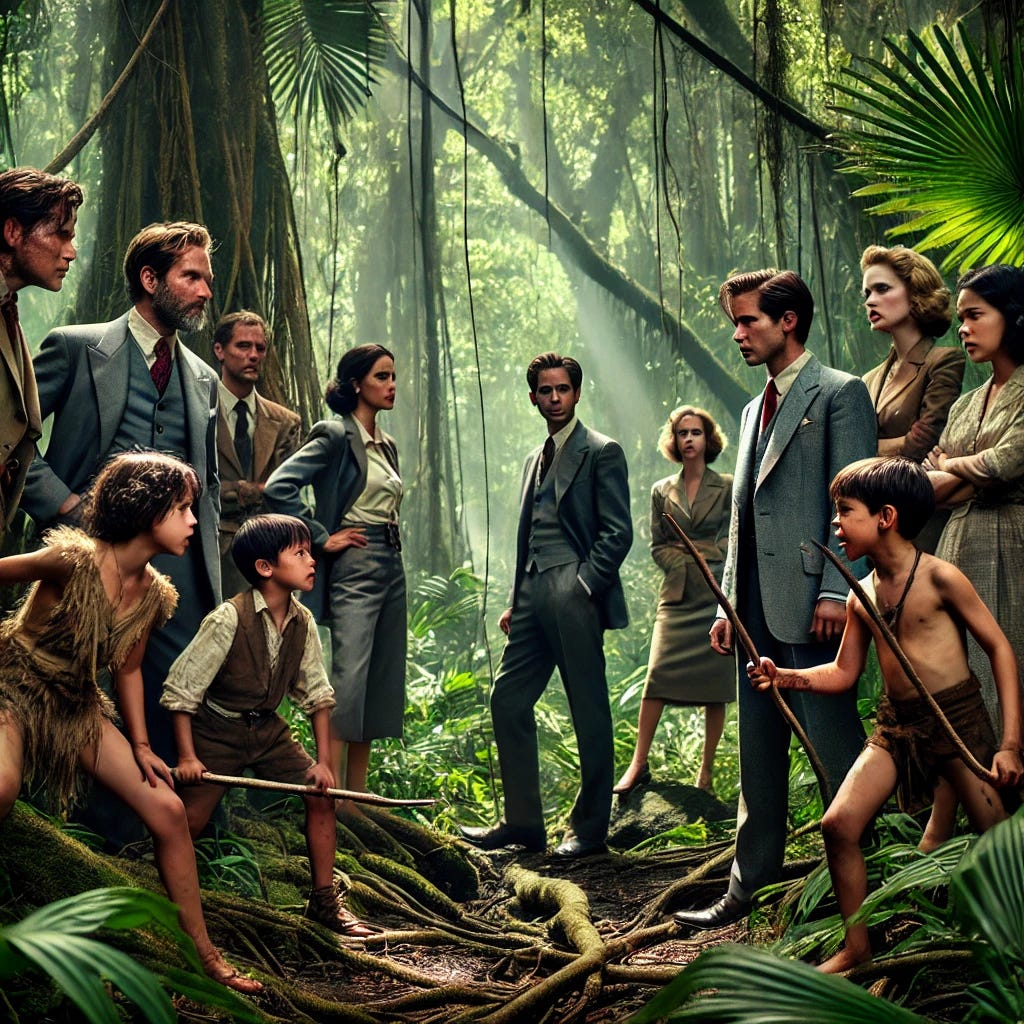Understanding the Hidden Forces: How Group Dynamics and Influence Shape Elections and Decisions
Exploring the Mechanics of Group Behavior and Its Impact on Democracy, With Insights and Lessons From Classic Films
With elections in France, the UK, and eventually the USA, it is worth considering group dynamics and their Influence. Of course, we all want to believe we are immune to these pressures, but few of us are. Given the reality of this Influence, it might be worth understanding what causes us to be affected, what we can do about it, and some ideas for some 'training' movies to see the dynamics in action.
What do we mean by Group Dynamics?
Group Dynamics refers to a group's attitudinal and behavioral characteristics. It encompasses the interactions and processes that occur within a group and how these interactions influence the behavior and attitudes of the group members. Understanding group dynamics is essential for managing groups effectively in various settings, including workplaces, educational environments, and social or community contexts.
Formation and Development Stages
Forming: This is the initial stage where group members meet and begin to form impressions of each other. This phase involves orientation and testing boundaries.
Storming: Characterized by conflict and competition as group members assert their opinions and jockey for positions. This stage is crucial for the establishment of clear roles and responsibilities.
Norming: The group establishes norms and practices that facilitate cooperation and cohesion. Members begin to work more harmoniously and develop a sense of unity.
Performing: The group becomes fully functional and works effectively to achieve its goals. Roles are clear, and members are committed to the group's objectives.
Adjourning (or Mourning): This final stage involves disbanding the group once its goals have been achieved. Members reflect on their achievements and the process.
Typical Roles and Responsibilities
Leader: Guides the group towards its goals, provides direction, and resolves conflicts.
Facilitator: Ensures that group discussions are productive and that all members have a chance to contribute.
Recorder: Keeps track of decisions, tasks, and essential information discussed during group meetings.
Challenger: Questions assumptions and pushes the group to consider alternative perspectives.
Communication Patterns
Verbal Communication: Using words to share information, express ideas, and coordinate activities.
Non-Verbal Communication: Body language, facial expressions, and other non-verbal cues that can influence group interactions.
Formal Communication: Official channels of Communication, such as meetings and reports.
Informal Communication: Casual interactions that occur naturally within the group, such as conversations during breaks.
Decision-Making Processes
Consensus: Decisions are made when all group members agree on a course of action.
Majority Rule: Decisions are made based on the preferences of the majority of group members.
Authority Rule: A leader or a small group decides on behalf of the larger group.
Groupthink and Polarization
Groupthink: A phenomenon where the desire for harmony and consensus leads to poor decision-making as critical thinking is suppressed.
Polarization: The tendency for group discussions to lead to more extreme positions than those initially held by individual members.
Understanding group dynamics helps foster better collaboration and teamwork. However, to be an effective leader, you need to understand group dynamics to manage teams more effectively, leading to improved performance and satisfaction. These include managing conflict within the groups and keeping focused on helping the group to make better decisions.
Creating better group dynamics
By analyzing and applying the principles of group dynamics, individuals and organizations can create more cohesive, compelling, and harmonious groups. Managing group dynamics effectively is crucial for the success and productivity of any team. Here are five ideas to better manage group dynamics:
1. Foster Open Communication
Techniques such as encouraging transparency, active listening, and regular check-ins can significantly impact the process. While some believe "no dissent implies agreement," these are often situations where those who do not agree to keep silent and resort to passive-aggressive behaviors.
2. Define Clear Roles and Responsibilities
Clearly define each team member's role and responsibilities to avoid confusion and overlap. Ensure everyone understands their specific tasks and how they contribute to the group's goals. Then, allocating tasks based on individual strengths and expertise improves efficiency and ensures that team members feel valued and motivated. In the end, you must establish a system of accountability where team members are responsible for their deliverables.
3. Promote Inclusivity and Collaboration
Build diverse and inclusive teams with varied backgrounds, skills, and perspectives. Diversity of thinking can lead to more creative solutions and better problem-solving.
4. Facilitate Conflict Resolution
Diverse teams disagree—that's the point of building broader teams. Early Intervention in conflicts before they escalate is essential. Encourage team members to discuss issues openly and honestly. As the leader, you may need to help mediate the issues but keep focused on solutions. Don't take it personally or make it personal.
5. Provide Training and Development
Team-building activities, skills development, and mentoring may feel like you are slowing down execution, but they will ultimately pay divisions.
All of these might seem obvious, but some are overlooked.
Let’s go to the videotape …
Several movies effectively explore the themes of group dynamics and Influence, offering valuable insights into how individuals interact within groups, how decisions are made, and how Influence is wielded. Here are some of the best movies in this genre:
1. 12 Angry Men (1957)
Overview: This classic film depicts a jury's deliberations in a murder trial, highlighting the processes of persuasion, conflict resolution, and the impact of individual biases on group decision-making.
Key Themes: Dissent, critical thinking, leadership, and bias.
2. The Breakfast Club (1985)
Overview: Five high school students from different social groups spend a Saturday detention together, learning about each other and themselves.
Key Themes: Stereotyping, social identity, and group cohesion.
3. The Social Network (2010)
Overview: The film chronicles the founding of Facebook and the conflicts that arose among its founders.
Key Themes: Power dynamics, ambition, collaboration, and betrayal.
4. Glengarry Glen Ross (1992)
Overview: Based on David Mamet's play, this film focuses on a group of real estate salesmen whose jobs are on the line. It showcases intense competition and ethical dilemmas.
Key Themes: Pressure, manipulation, competition, and ethics.
5. Dead Poets Society (1989)
Overview: An English teacher at a conservative boys' school inspires his students to challenge the status quo and embrace individual expression.
Key Themes: Leadership, Influence, conformity, and rebellion.
6. Remember the Titans (2000)
Overview: The film tells the true story of a high school football team overcoming racial tensions and coming together to succeed.
Key Themes: Teamwork, leadership, racial integration, and conflict resolution.
7. A Beautiful Mind (2001)
Overview: Based on the life of mathematician John Nash, this film explores his struggles with schizophrenia and how it affects his relationships and career.
Key Themes: Collaboration, mental health, support systems, and intellectual Influence.
8. Office Space (1999)
Overview: A comedy about disillusioned office workers who rebel against their oppressive work environment.
Key Themes: Workplace dynamics, motivation, and resistance to authority.
9. The Wave (2008)
Overview: A high school teacher's experiment to demonstrate the dangers of autocracy spirals out of control as students form a fascist group.
Key Themes: Authority, conformity, power, and groupthink.
10. Whiplash (2014)
Overview: A young jazz drummer's intense relationship with his demanding music teacher explores themes of ambition, mentorship, and psychological manipulation.
Key Themes: Authority, ambition, mentorship, and psychological pressure.
11. The Stanford Prison Experiment (2015)
Overview: A dramatization of the real-life psychological experiment conducted at Stanford University investigated the effects of perceived power in a simulated prison environment.
Key Themes: Power dynamics, authority, and ethical boundaries.
12. Lord of the Flies (1963 and 1990)
Overview: Adaptations of William Golding's novel about a group of boys stranded on an uninhabited island, exploring their descent into savagery.
Key Themes: Leadership, anarchy, and human nature.
These films provide rich material for examining various aspects of group dynamics and Influence, making them excellent resources for learning and discussion, maybe even as part of a training or kick-off session.
During any election period, those we hang around with and form groups around can influence how we think and how we even vote. Then again, the force of your personality may allow you to overcome the negative impacts of group dynamics. Or that might be a story you are telling yourself.





